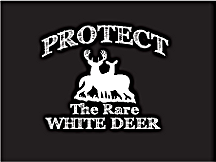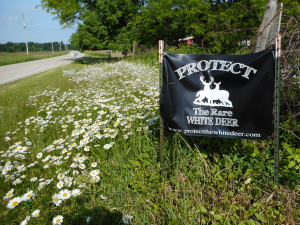
Dear Laura (or How to Protect Your White Deer)
April 2, 2024

A sign near Leland, Wisconsin raises awareness of the area’s white deer.
Readers sometimes contact the White Deer website with news or pictures of a white deer they have seen. They are excited to share their encounter, but also anxious about the safety of the deer and eager to know how to protect it. The following letter was received several years ago from a Colorado resident. It is very similar to other letters the website has received. Below Laura’s letter is the answer that was sent back and could be used as a general guide for residents of other states as well, the majority of which have no white deer protection.
Email from Laura B. (August 2018):
Hi!
There is a white fawn that lives here in (her city), CO. She is beautiful and has been living across the street from me in the alfalfa fields with her mother. I am worried she doesn’t stand a chance. Is there anything I can do to help protect her?
Sincerely,
Laura B.
Dear Laura (or whoever),
First off, it’s wonderful to hear about your white deer sighting–it really is a once in a lifetime event. We have a number of white deer in our area and it never gets old seeing them. They are incredible!
As far as protecting the deer, this will be a tough one. Colorado (or whatever state) does not have white deer protection. Even in places where a particular white deer was extremely well known and popular with locals, a hunter was able to legally shoot it. The uproar was enormous, but it always boils down to what the law is. So, if there is no legal protection, you will not have much luck–at least in the short run.
You are dealing with a “Catch 22” here: you need to tell other people about the white deer to galvanize support for protection, but in doing so, you also advertise the deer to hunters. It is a gamble we made here in the Leland area where a section of the state did legalize hunting white deer for about five years as part of an effort to control CWD (Chronic Wasting Disease). We have lost some deer because of the publicity, but were also successful in reinstating protection in those areas.
My first recommendation is to find a legislator who is sympathetic to your cause. We were lucky to have a local legislator who was really active and knowledgeable and was able to get our local law changed. Don’t underestimate the power of one person to affect change–both the enactment of protection in a few states and, unfortunately, the removal of protection (Michigan, Minnesota, Oklahoma, for example) was largely done through the efforts of one person.
Be careful not to make white deer protection an anti-hunter issue. In Wisconsin, the majority of hunters like the white deer and want them protected. You may find this is also the case in Colorado (or wherever). You need their support to help with legislative change.
My second recommendation would be to write letters to newspapers or news sites. Tell people about white deer and how unique and special they are. A lot of public sentiment is based on knowledge, and most people, including hunters, know nothing about white deer. Just getting the information out there will gather much interest and support…and may even garner sightings from other parts of Colorado (or whichever state). It might be a good idea, however, to keep any locations very general to avoid tipping off trophy hunters.
Another consideration: Hunting attitudes regarding white deer have been shaped for decades by some major and very destructive misinformation. Some so-called “experts” have repeatedly told hunters that white deer are defective and need to be removed from the herd. The truth is that the color is recessive and most of these animals are not defective in any way, nor is the color (which is recessive) in danger of taking over the herd. It is very important to correct these myths.
You also might try to contact the cultural affairs people from your local Native American tribe(s). Virtually all Native people considered white deer sacred. They were very respectful of the deer and believed they were spirit creatures. The current attitude about shooting white deer is totally the opposite. I think it’s important to bring back at least some of that respect–another case where educating the public is important.
Some of what happens next depends on the sex of your deer. If it is a doe, she will typically stay close to her birth family and not venture very far–which is good if your neighbors feel the same way you do.
If your deer is a buck, it could end up traveling a fair distance to establish new territory and be more at risk. We’ve had more than one white deer (with a dark spot and therefore legal game in Wisconsin) trot onto public land or a farm where someone was able to shoot it–despite the fact that the vast majority of landowners in the area protect these deer.
Hopefully your fawn will reach adulthood, be able to breed, and pass on its white genes. If worse comes to worse and the deer is killed, there is a chance that the white color could surface again in the population. You need a white gene from each parent to get a white fawn, so there is already another deer in your area that also carries that gene.
Please use our website as a resource. It contains a ton of information on white deer (laws, science, news stories, etc.) that can be used to learn about the deer and include in a letter or article. The information is the result of hundreds and hundreds of hours of research, so it is pretty sound.
Thanks for contacting our website and good luck!
Protect the White Deer
Post Script: The white deer that Laura was concerned about lived to be five years old. It was eventually found dead close to a busy highway and was probably hit by a car. The city where the deer was frequently seen enacted a law to protect the deer while it lived. The deer was a much loved part of the community.

